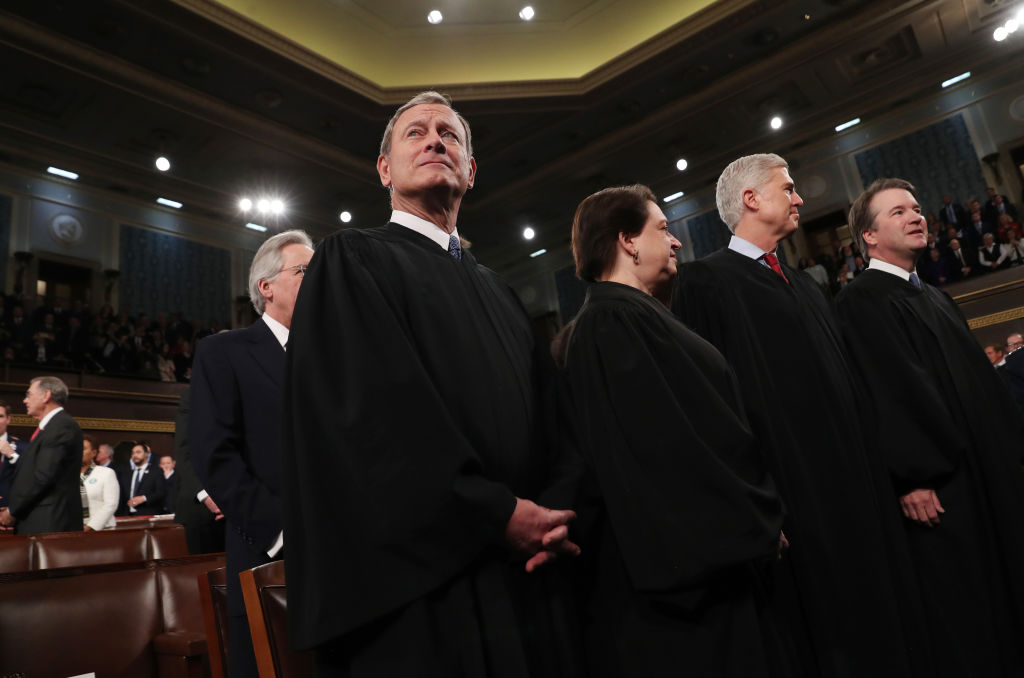It’s safe to assume that a book referring to The Dispatch’s Jonah Goldberg as a “right-wing pop historian” is not worth taking seriously. Anyone looking to confirm that assumption can simply read Michael Waldman’s The Supermajority: How the Supreme Court Divided America.
Waldman—the president and CEO of the Brennan Center for Justice and a professor at NYU School of Law—paints legal conservatism as a grand anti-democratic conspiracy. He describes the Federalist Society as a “real deal” plot against democracy and portrays the court’s current Republican-appointed majority as partisan hacks and sellouts dressed up in robes. (“Dobbs and Bruen were for the Republican Party voters; West Virginia v. EPA was for the paying customers.”)
The overcharged rhetoric in The Supermajority could be forgiven if Waldman fleshed out substantive disagreements with conservative jurisprudence. But that wouldn’t feed the “illegitimacy” narrative in vogue among certain think pieces, nor prove the existence of a deep state-like cabal of extreme right-wing justices. Instead, Waldman doubles down on left-wing conspiratorial claims reminiscent of right-wing ones that sought to overturn a presidential election in 2020. It’s just this time they’re directed at the integrity of Article III instead of Article II.
Waldman wanders across a lot of ground in The Supermajority. In surveying the history of American “court fights,” he recounts the sparse debates about the power of the Supreme Court in the Constitutional Convention of 1787; the infamous Dred Scott decision by Chief Justice Roger Taney; the judicial overreach during the Lochner-era in the early 1900s; FDR’s failed court-packing plan; and the activism of the Warren Court in the 1950s and ’60s. While he acknowledges that the Warren Court grew “unmoored” and even criticizes the subsequent Burger Court for its “hubris,” Waldman’s main goal is to emphasize the novel dangers posed by the conservative Roberts Court.
Problem is, he makes too many missteps along the way to offer a serious case.
Waldman misunderstands America’s constitutional order. He writes that the Constitution designed a system where “Sovereignty was held by the legislature, chosen by the people.” Not exactly. Sovereignty was held by the people, who then set up constitutions that would constrain legislatures, executives, and judges alike. As founding father and future Supreme Court Justice James Wilson once explained, “By the term constitution,” the framers referred to the “supreme law, made or ratified by those in whom the sovereign power of the state [society] resides.” That is, the people.
Exalting the legislature in this way helps make the court’s thwarting of legislative will in the name of the Constitution seem unacceptable. Waldman further supports his narrative of the court’s antidemocratic maneuvering by reducing the Constitution to a set of vague, open-ended principles: If the Constitution is in fact so vague that it doesn’t meaningfully restrain modern government, then judicial decisions purporting to enforce the Constitution over our democratic will today seem objectionable—and maybe even illegitimate. According to Waldman, the Constitution employs “deliberately vague language,” and key provisions like the 14th Amendment use “grand but broad terms.” This is not a new argument. Early 20th century legal progressives like Justice Felix Frankfurter shared similar premises, and Justice Robert Jackson famously extolled the “majestic generalities of the Bill of Rights.” If the supreme law of the Constitution is fundamentally indeterminate, then it doesn’t constrain political actors very much. The will of the people acting through their legislatures in the states and Congress should carry the day.
The issue for contemporary liberals is that this brand of progressive judicial restraint lost out to judicial activism and was relegated to dissent. The notoriously activist Warren Court happened, and Justice Jackson penned his famous line while invalidating a democratically enacted law. Waldman and other legal liberals of his generation grew used to judges filling in the many supposed gaps in the Constitution—and doing so in accordance with liberal policy goals. They still view the law like Frankfurter, but they’re used to ruling like Warren. In The Supermajority, this highlights a deep, unresolved tension between Waldman’s underlying premises and his preferred practice.
No wonder Waldman offers an anguished and confused critique of the Roberts Court. He is puzzled, for example, by how the court could strike down a democratically enacted gun restriction in the 2022 case of New York State Rifle & Pistol Association v. Bruen and then beat the drum of judicial restraint by allowing state legislatures to set abortion policy just a day later in Dobbs v. Jackson Women’s Health Organization. Surely this is raw hypocrisy: judicial restraint and democratic deference for thee but not for me, no?
Well, no. Legal conservatives find more legal determinacy in the Constitution than their liberal counterparts. As Justice Kavanaugh once put it, “the Constitution is largely a document of majestic specificity.” The fact that the Second Amendment is in the Constitution, while an abortion protection is not, explains the distinct outcomes in Bruen and Dobbs—not partisan hackery. The text of the Constitution prevents legislatures from infringing on one asserted right but not the other.
There’s room to dispute that logic, but The Supermajority isn’t up to the task. Waldman observes a “jarring disconnect” between Bruen and Dobbs, as the Republican- and Democratic-appointed Justices seemed to switch sides on the question of judicial restraint. But he is unable to offer a coherent resolution to the supposed tension by consistently deferring to legislative judgment. That would require agreeing with Dobbs’ assessment that Roe constituted a judicial usurpation of power away from the people (something old-school liberals used to be willing to admit, but for which they’re now under fire from progressives).
Instead, Waldman goes all in on stare decisis—the theory that the court should defer to its past judgments—with respect to abortion. Part of the problem with this sort of critique of the conservative “supermajority,” as Professor Jonathan Adler has observed, is that the Roberts Court overturns precedents at a much lower rate than its predecessors.
That Waldman failed to provide a coherent account of why the current court is so wrong as to be illegitimate is understandable. It would presumably entail advocating more unbending judicial restraint across the board—something few legal liberals today will do.
What’s less understandable and more frustrating is the number of inaccuracies that The Supermajority contains. Waldman writes, for example, that Dobbs was “the first explicit repeal of a judicially recognized fundamental right in the country’s history.” That’s not true. As Yale Law Professor (and no conservative) Akhil Amar has explained, the court overturned precedents recognizing individual rights to contract and economic liberty during the New Deal era.
Waldman also misquotes the statutory provision at issue in another recent case, West Virginia v. EPA, and then misconstrues the court’s holding. Waldman writes that in West Virginia, which centered on the Environmental Protection Agency’s interpretation of the Clean Air Act, “The Court did not claim that the agency had misread the statute.” Except it did. That was the crux of the decision—that Congress had not in fact given the EPA the authority to engage in generation shifting under the Clean Air Act.
Could Waldman’s willingness to play fast and loose with the facts, and to indulge the language of conspiracy rather than delving into the nitty-gritty details of law, be the sort of phenomenon actually dividing America and driving public backlash against the allegedly “illegitimate” court? Justices have been making consequential and divisive legal decisions about which reasonable people of goodwill vehemently disagree for quite some time. But the frenetic attacks on the court—the equivalence between “the Court is wrong” with “the Court is illegitimate”—by intellectuals, journalists, and thought leaders seems different in kind from past court fights.
Contrary to Waldman’s subtitle, it might not be the Supreme Court that “divided America.” As is true for much of our division-inducing discourse, spin and sloppiness are the real culprits. And on that front, Waldman is complicit.






Please note that we at The Dispatch hold ourselves, our work, and our commenters to a higher standard than other places on the internet. We welcome comments that foster genuine debate or discussion—including comments critical of us or our work—but responses that include ad hominem attacks on fellow Dispatch members or are intended to stoke fear and anger may be moderated.
With your membership, you only have the ability to comment on The Morning Dispatch articles. Consider upgrading to join the conversation everywhere.